URBANIZATION AND INDUSTRIALIZATION
Economic%20Report%20on%20Africa%202017%20UNECA
Economic%20Report%20on%20Africa%202017%20UNECA
Create successful ePaper yourself
Turn your PDF publications into a flip-book with our unique Google optimized e-Paper software.
82<br />
ECONOMIC REPORT ON AFRICA 2017<br />
urbanization exhibit almost no difference between<br />
urban and rural areas in access to basic services.<br />
The growing concentration of people in cities will<br />
also have implications for health outcomes in Africa.<br />
With high population densities, cities account for<br />
a large and growing proportion of people living<br />
with HIV, tuberculosis (TB) and other diseases.<br />
For instance, there is evidence that the risk and<br />
vulnerability to HIV and TB infection is often higher<br />
in urban areas (UN Habitat and UNAIDS, 2015).<br />
At the same time, as centers of economic growth,<br />
education, innovation, social change and their own<br />
resources and regulatory powers to reach large<br />
numbers of people (Nairobi City County, 2016),<br />
cities are uniquely positioned to forge inclusive<br />
and participatory responses to HIV, TB and other<br />
diseases and take transformative action to ensure<br />
that services are delivered to all its citizens.<br />
RURAL–URBAN MIGRATION<br />
As evident from the preceding discussion, many<br />
African countries are in the first phase of urbanization<br />
and, unsurprisingly, have large urban–rural disparities<br />
in access to basic services. Consequently, people<br />
are “pulled” by social and economic opportunities<br />
or “pushed” by environmental deterioration, so<br />
that migration is an important component of urban<br />
population growth in Africa. Moving to cities is also<br />
often rural agricultural workers’ primary method<br />
to diversify income (Banerjee and Duflo, 2006).<br />
Indeed, it can be a very productive move, even<br />
for temporary migrants (Bryan, Chowdhury and<br />
Mobarak, 2011).<br />
The growing concentration of<br />
people in cities will also have<br />
implications for health outcomes<br />
in Africa. Cities account for a<br />
large and growing proportion<br />
of people living with HIV,<br />
tuberculosis (TB) and other<br />
diseases and there is evidence<br />
that the risk and vulnerability<br />
to HIV and TB infection is<br />
often higher in urban areas.<br />
Cities are uniquely positioned to<br />
forge inclusive and participatory<br />
responses to health challenges<br />
and take transformative action<br />
to ensure that services are<br />
delivered to all its citizens.<br />
Although African cities have grown quickly over<br />
the past 50 years, rural–urban migration has played<br />
a relatively small role in recent growth (Kessides,<br />
2007; Potts, 2012), and in such African countries as<br />
Côte d’Ivoire, is even negative (Beauchemin, 2011).<br />
Similarly, based on the conservative assumption that<br />
rural and urban population growth is equivalent,<br />
De Brauw, Mueller and Lee (2014) find that the<br />
population weighted rural–urban migration rate<br />
was 1.07 per cent a year between 1990 and 2000<br />
in Africa, with substantial heterogeneity at country<br />
level. Although several countries have rural–urban<br />
migration rates of around 1 per cent, a few have<br />
very slow or negative rural–urban migration rates,<br />
while some experienced rates of over 2 per cent<br />
annually in the 1990s. 7 It is likely that the rural–<br />
urban migration rate in most African countries after<br />
2000 was in the same broad range, though data<br />
scarcity precludes confirmation.<br />
International migration has received more attention<br />
in recent debates on migration in Africa, yet internal<br />
migration (migration within countries) is far higher in<br />
numbers of people and perhaps even in the volume<br />
of remittances and these funds’ poverty reduction<br />
potential (UNDP, 2009). However, the capacity of<br />
urban towns is limited to plan for urban growth and<br />
accommodate the internal migrants by providing<br />
employment and access to land and basic amenities.<br />
People who leave the countryside to find better<br />
lives in the city often have no choice but to settle<br />
in shanty towns and slums, where they lack access<br />
to decent housing, sanitation, health care and<br />
education—in effect trading rural for urban poverty.<br />
Consequently, migration has shifted the locus of<br />
global poverty to the cities, a process recognized as<br />
the “urbanization of poverty” (UN-Habitat, 2003).<br />
Yet rural–urban migration in particular is seen as<br />
creating pressure on the urban infrastructure,<br />
environment and employment, and there is an<br />
underlying assumption among policymakers that<br />
the phenomenon is linked to rising levels of urban<br />
poverty. This perception misleads, however, because


